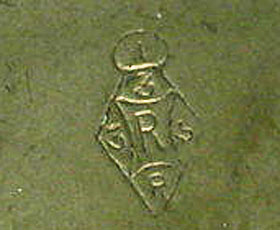Looking Glass

Needle Case (photographs from eBay, now part of Lynda Herrod's collection)

Design Representation
Note: The diamond registration mark on this item translates to August 3, 1875 which doesn't match the date this design was
registered. After a review of all metal designs registered with TNA on August 3, 1875, it was discovered that there were only two designs
registered on that date, one to Coggins & Baxter (#293201 - Bird Cage needle case) and one to another company in Sheffield not related to
needle cases. It appears as though Coggins & Baxter accidently used the diamond mark for the Bird Cage on their Looking Glass needle
case. Coggins & Baxter made a similar mistake on their Lap Desk - Floral needle case.
Design Details
Needle Case Type: |
Figural |
Patent/Registered to: |
Coggins & Baxter - Birmingham |
Patent/Design Representation #: |
Ornamental Class 1: Metal: #312186 (Provisional Design #1352 registered March 13, 1877) |
Patent/Design Registration Date: |
July 25, 1877 |
Location of Patent/Design Registration: |
The National Archives (TNA) - Kew, UK |
Reference #:
|
TNA Representation - BT 43/42/312186
TNA Register - BT 44/4/312186 |
Dimensions: |
6 x 5 |
Material: |
Brass |
Name Variations: |
a. W. Avery & Son - Redditch
b. Unmarked |
Other Variations: |
None |
Additional Photographs


Back and side views


Bottom and upmarked back detail views


Diamond registration mark dated August 3, 1875 and back stamped with the W. Avery & Son Redditch name

Detail view of the W. Avery & Son Redditch name stamped on the back
Facts
A looking glass or mirror is a smooth surface of glass coated with a metal amalgam that reflects light to provide a clear representation of an
image. Although mirrors are normally used for personal grooming and decoration, some have scientific applications such as the ones in
telescopes, lasers and cameras. Mirrored glass is also used in architecture to give a building or structure the ability to reflect its
surrounding skyline as is often seen on high-rise buildings in major cities.

History
Early mirrors were made of obsidian, a shiny volcanic rock, and date to around 6000 BC. The first metal-coated glass mirrors were invented
in the Middle East and are mentioned by the Roman author, Pliny, in 77 AD. Although the Chinese began working with silver-mercury amalgams in
the 5th century AD, it was 16th century Venetians, already known for their glass making techniques, who created a tin mercury amalgam leading to
their dominance in mirror production. These mirrors were considered luxury items and were only available to the wealthy class due to their
cost. A German chemist invented a new silver-glass mirror process in 1835 which combined with the mass production technologies of the
Industrial Revolution brought mirror ownership to the masses. During the Victorian Period portable table swivel mirrors, hand mirrors and wall
mirrors were common not only for their functionality but also for decorative purposes. Today mirrors are found in most homes and sculpture
like the mirrored Cloud Gate at Millennium Park in Chicago (seen below) are popular tourist attractions.

Miscellaneous
One of the most intriguing artworks with a mirror is The Arnolfini Wedding by the early Dutch painter Jan van Eyck, painted in 1434 on
an oak panel. Van Eyck is known for his symbolism and attention to detail which can be seen in the mirror on the back wall between the wedding
couple. Some art scholars believe the mirror represents the eye of God witnessing the wedding vows. Not only does the mirror reflect the
back view of the couple but also includes two additional figures in the doorway, one of these possibly the painter himself. This mirror’s frame
includes tiny scenes from the Passion of Christ. Click on the photo of the mirror below to see a larger version of this painting.

















